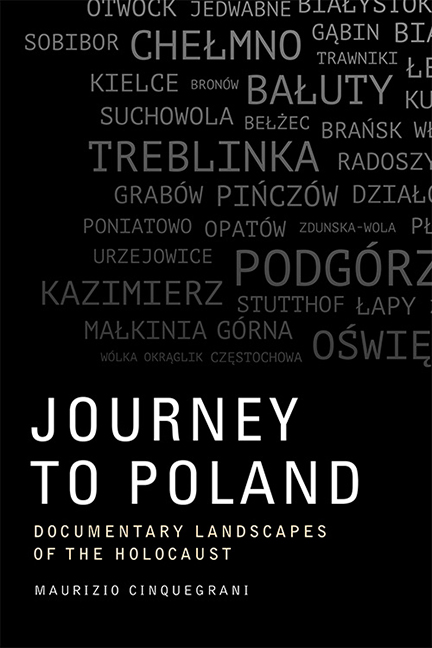Book contents
- Frontmatter
- Contents
- List of Figures
- Acknowledgements
- Dedication
- Prologue: Space, Time and the Holocaust
- 1 Countryside, Shtetl, City: The Murders of Mazovia, Jedwabne and Kielce
- 2 Conflicting Memories in the Shtetlekh Gąbin, Suchowola, Brańsk and Luboml
- 3 The Marketplaces of Postmemory in the Shtetlekh Eishyshok, Delatyn, Opatów, Zdunska Wola, Urzejowice and Pińczów
- 4 A Tale of Two Cities: Warsaw and Kraków
- 5 Another Tale of Two Cities: Lviv and Łódź
- 6 A Tale of Two Cities of Death: Treblinka and Oświęcim
- Epilogue: New Routes
- Bibliography
- Filmography
- Index
6 - A Tale of Two Cities of Death: Treblinka and Oświęcim
Published online by Cambridge University Press: 10 November 2020
- Frontmatter
- Contents
- List of Figures
- Acknowledgements
- Dedication
- Prologue: Space, Time and the Holocaust
- 1 Countryside, Shtetl, City: The Murders of Mazovia, Jedwabne and Kielce
- 2 Conflicting Memories in the Shtetlekh Gąbin, Suchowola, Brańsk and Luboml
- 3 The Marketplaces of Postmemory in the Shtetlekh Eishyshok, Delatyn, Opatów, Zdunska Wola, Urzejowice and Pińczów
- 4 A Tale of Two Cities: Warsaw and Kraków
- 5 Another Tale of Two Cities: Lviv and Łódź
- 6 A Tale of Two Cities of Death: Treblinka and Oświęcim
- Epilogue: New Routes
- Bibliography
- Filmography
- Index
Summary
‘The earth beneath my feet was coarse and sharp: filled with the fragments of human bone.’
— Martin Gilbert, The Holocaust: The Jewish TragedyThe documentaries discussed in the previous chapters have addressed the ways in which the destruction of the Jews resulted in the annihilation of countless communities and displaced millions of men, women and children from their shtetlekh and their neighbourhoods, while creating new kinds of places where the victims were concentrated, exploited and eventually murdered. This chapter presents a topographical shift in focus from the places inhabited by the Jews before and during the war to the spaces designed for their extermination in the context of what should not be understood as one event, but rather as a succession of small- and large-scale actions that brought Eastern European Jewry to its destruction. Within the myriad of events constituting the Holocaust a continuity can be established between the early pogroms and the death marches which followed the liberation of the camps, between the burning barn in Jedwabne and the four crematoria of Auschwitz II-Birkenau, and between all the crime scenes that swallowed the Jews of Poland. The Holocaust in the territories of the Second Polish Republic occurred in a variety of locations and by means of various ways of execution, including shooting, hanging and the use of gas vans and gas chambers operating either with exhaust fumes or with the cyanide-based pesticide Zyklon B. In the west, Chełmno extermination camp operated from December 1941 to March 1943 and again from June 1944 to January 1945; between 152,000 and 340,000 Jews were killed here. In the east, between October 1941 and November 1943, as many as two million Jews were murdered in the death camps Bełżec, Sobibór and Treblinka during the German mass-murder operation known as Aktion Reinhard. In March 1942 the first gas chamber at Auschwitz II-Birkenau became operational, and by November 1944 at least 1,100,000 people, mostly Jews, were killed in this killing factory. Hundreds of thousands of children, men and women were also murdered in concentration camps such as Majdanek, near Lublin, and Stutthof, near Gdańsk, in particular during operations such as Aktion Erntefest, the mass shooting of 43,000 Jews which took place on 3 November 1943 in the territory of the General Government.
- Type
- Chapter
- Information
- Journey to PolandDocumentary Landscapes of the Holocaust, pp. 146 - 178Publisher: Edinburgh University PressPrint publication year: 2018



